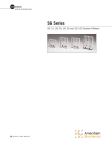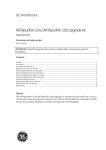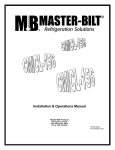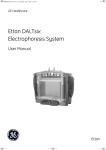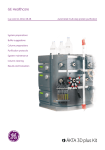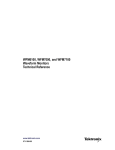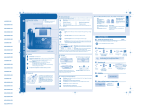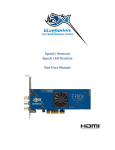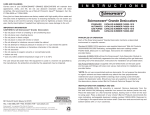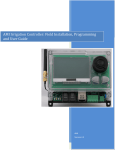Download Ettan DALTsix - GE Healthcare Life Sciences
Transcript
GE Healthcare Ettan DALTsix Gradient Maker User Manual Important user information All users must read this entire manual to fully understand the safe use of Ettan DALTsix. Note The Note sign is used to indicate information important for trouble-free and optimal use of the product. Installation Contents 1 Contents 1 Ettan DALTsix Gradient Maker 2 Generating linear gradients 2.1 Pouring gradients from the top...............................................................................10 2.2 Pouring gradients from the bottom.......................................................................10 3 Generating convex and concave exponential gradients 4 Care and maintenance 5 Ordering information 6 Technical service and repair 7 Important repacking instructions Ettan DALTsix Gradient Maker User Manual 80-6487-55 Edition AB 1 Installation Contents Ettan DALTsix Gradient Maker User Manual 80-6487-55 Edition AB Installation Ettan DALTsix Gradient Maker 1 1 Ettan DALTsix Gradient Maker The Ettan™ DALTsix Gradient Maker is designed for producing linear gradients of aqueous solutions ranging in volume from 200–1 000 ml. It can be used to form convex and concave exponential gradients with the addition of a one-holed rubber stopper, a piece of rigid tubing and a piece of flexible tubing. The unit is fabricated from cast acrylic plastic. reservoir (back) chamber connector channel mixing (front) chamber slide stop slide valve outlet connector Fig 1. Ettan DALTsix Gradient Maker Ettan DALTsix Gradient Maker User Manual 80-6487-55 Edition AB 1 Ettan Installation DALTsix Gradient Maker Ettan DALTsix Gradient Maker User Manual 80-6487-55 Edition AB Generating linearInstallation gradients 1 2 2 Generating linear gradients To generate a linear gradient between two concentrations, equal volumes of solutions of the two concentrations are measured into the two chambers of the gradient maker. As solution is delivered out of the mixing chamber, an equal volume flows in from the reservoir chamber where it is rapidly diluted and mixed to uniformity. The initial concentration delivered will be that of the solution in the mixing chamber, the final concentration will be that of the reservoir chamber. For the most consistent delivery of gradients, a peristaltic pump is recommended. 1 Make sure all parts are clean and liquid flows freely through the connecting channel of the slide valve and the pump and delivery tubing. 2 Add a magnetic stir bar of the appropriate dimensions (20–30 mm long) to the mixing chamber and place the unit on a magnetic stirrer. If volumes will be less than half the capacity of the unit, an identical stir bar should be placed in the reservoir chamber as well to balance the displacement and prevent backflow into the reservoir when the chambers are first connected. Connect tubing to the outlet connector and pump, and adjust pump speed, if used. Position or connect the tubing to the receiving vessel (gel casting unit, centrifuge tube, etc.) 3 Close the slide valve (out on side of white slide stop button, Fig 2). If the outlet tubing is not controlled by a pump, clamp it off near the gradient maker. Add the required volume of the final solution to the reservoir (back) chamber. connector channel slide stop open closed Fig 2. Open and closed positions of slide valve. 4 Carefully open the slide valve and allow just enough solution to flow through the connector channel to fill it to the edge of the mixing chamber, then close the valve. Be sure no large bubbles remain to obstruct flow through the channel. 5 Add the required volume of the starting solution to the mixing chamber and start the magnetic stirrer. 6 Open the outlet tubing if clamped off. Ettan DALTsix Gradient Maker User Manual 80-6487-55 Edition AB 1 Generating 2 Installation linear gradients 7 Start the pump then open the slide valve to the open position. 8 When casting acrylamide gels, it is important that no bubbles disturb the gradient. Watch the delivery carefully and as soon as the last of the solution has entered the pump head, stop the pump and clamp off the tubing to the receiving container. 9 Flush and rinse all parts thoroughly with distilled water after use. Note: If there is a substantial difference in densities between the two solutions, there will be a sudden flow from the denser chamber to the lighter chamber to bring the two into hydrostatic balance. This will result in the gradient not being fully linear. To avoid this, add equal weights, rather than volumes, of the solutions to the appropriate chambers. 2.1 Pouring gradients from the top Filling a container with a gradient (e.g. casting acrylamide pore gradient gels) can be done either dense solution first (“from the top”), or light solution first (“from the bottom”). To fill from the top: 1 Proceed as described above, putting light (final or top) solution in the reservoir chamber (step 3) and dense solution in the mixing chamber (step 5). 2 Place the delivery outlet against the upper edge of the receiving container. Adjust the pump rate so that the solution flows evenly down the side in a smooth, continuous stream. The delivery speed should be slow enough that the newly arriving solution does not mix with the underlying solution. Alternatively, using a rigid cannula at the end of the delivery tubing, hold the tip of the cannula just above the surface of the solution, raising it smoothly as the container fills. 2.2 Pouring gradients from the bottom This technique is commonly used in filling multiple gel casting chambers. 10 1 Proceed as described above, putting dense (final or bottom) solution in the reservoir chamber (step 3) and light solution in the mixing chamber (step 5). 2 In step 2, connect the outlet tubing to the bottom inlet of a gel casting unit or to a cannula long enough to reach the bottom of the receiving container. Adjust the pump rate so that the solution is not forced up in a “fountain” that mixes with the overlying solution. 3 If all of the gradient solution must be delivered to the container, a displacement solution may be used. Just as the last of the gradient mix is pumped out of the mixing chamber, add an appropriate volume of a denser displacement solution to the mixing chamber and pump it through until all of the gradient mix has been delivered. It is convenient to include a dye in the displacement solution to visually track the boundary between the gradient mix and the displacement solution. Ettan DALTsix Gradient Maker User Manual 80-6487-55 Edition AB Generating convex and concave exponentialInstallation gradients 31 3 Generating convex and concave exponential gradients Cout = Eq 1 CmixVmix + CresVout Vmix + Vout By holding the volume in the mixing chamber constant (as opposed to declining for linear gradients), the gradient generated will have an exponential concentration curve. The mixing volume in the gradient maker unit can be held constant by sealing the top of the mixing chamber with a rubber stopper and tubing assembly (Fig 3). The total volume of the gradient can be greater than the maximum volume of the gradient maker because additional solution can be repeatedly added to the reservoir chamber. Using Eq 1, examples of the gradients generated by various combinations of volumes and concentrations listed in Table 1 are plotted in Fig 4. Concave gradients are generated high concentration first, and thus gel cassettes must be filled from the top. For convex gradients, cassettes must be filled from the bottom. Most frequently used is the concave pore gradient for increased resolution in the high molecular weight region of acrylamide gels. To generate an exponential gradient: 1 Make sure all parts are clean and liquid flows freely through all channels, stopcocks and tubing. 2 Assemble the stopper. Select a one-hole rubber stopper that fits securely in the top of the mixing chamber. Attach a short piece of flexible vinyl tubing that can be clamped off to make an airtight seal to a rigid piece of glass or plastic tubing that fits tightly in the hole of the stopper. The stopper assembly should seal the mixing chamber airtight when the slide valve is closed and the outlet tubing is clamped off. 3 Add a magnetic stir bar of the appropriate dimensions (20–30 mm long) to the mixing chamber and place the unit on a magnetic stirrer. Connect tubing to the outlet connector and pump, then adjust pump speed, if needed. Position or connect the tubing to the receiving vessel (gel casting unit, centrifuge tube, etc.) at top or bottom, as appropriate. 4 Close the slide valve and add a portion of the final solution to the reservoir (back) chamber. 5 Carefully open the slide valve and allow just enough solution to flow through the connector channel to fill it to the edge of the mixing chamber, then close the valve. Be sure no large bubbles remain to obstruct flow through the channel. 6 Add the required volume of the starting solution to the mixing chamber. With the stopper tubing open, insert the stopper assembly securely into the mixing chamber (Fig 3). Clamp off the tubing on the vent airtight. 7 Start the magnetic stirrer and unclamp the outlet tubing if needed. Ettan DALTsix Gradient Maker User Manual 80-6487-55 Edition AB 11 1 Generating 3 Installation convex and concave exponential gradients reservoir chamber mixing chamber Fig 3. Gradient Maker with stopper in place 8 Simultaneously open the slide valve and start the pump. 9 Stop the pump and remove the tubing from the receiving container as soon as the last of the solution has left the reservoir chamber. 10 Disconnect tubing. Flush and rinse all parts thoroughly with distilled water after use. Note: If the gradient volume is larger than the reservoir will hold, the additional volume can be added during the gradient delivery. Do not allow the reservoir chamber to go dry as bubbles will be pulled into the mixing chamber, changing the dilution volume and gradient shape. Note: The entire solution remaining in the mixing chamber is at the final concentration and does not contribute further to the gradient. If desired, it can be used as a displacement solution for convex gradients unless it contains acrylamide. Table 1. Examples of concave and convex exponential gradients A Cmix* 1 Vmix 20 B C D E 0 0 0.5 1 2050 20 20 Cres 0 1 1 1 0.5 Vres 100 100 10 100 100 * volumes are relative. c: concentration, v: volume, mix : mixing chamber, res : reservoir chamber 1.0 0. D 0.8 B concentration 0.7 0.6 E 0. 0.4 0.3 A 0.2 C 0.1 0.0 0% 20% 40% 60% 80% 100% % of gradient delivered Fig 4. Examples of exponential gradients 12 Ettan DALTsix Gradient Maker User Manual 80-6487-55 Edition AB Care and maintenance Installation 1 4 4 Care and maintenance The gradient maker should be cleaned thoroughly with distilled water after use to prevent polymerization or crystallization of solutions in the chambers and stopcocks. Do not use abrasives, acetone, pure alcohols or organic solvents to clean this unit. Ettan DALTsix Gradient Maker User Manual 80-6487-55 Edition AB 13 1 Care 4 Installation and maintenance 14 Ettan DALTsix Gradient Maker User Manual 80-6487-55 Edition AB Installation 5 1 Ordering information 5 Ordering information product quantity code number Ettan DALTsix Gradient Maker, 1000 ml total volume 1 80-6487-36 Ettan DALTsix Gradient Maker outlet connector fitting, white, 4–5 mm 4 80-6488-31 Ettan DALTsix Gradient Maker push-pull slide valve replacement 1 80-6198-37 Ettan DALTsix Gradient Maker User Manual 80-6487-55 Edition AB 15 1 Ordering 5 Installation information 16 Ettan DALTsix Gradient Maker User Manual 80-6487-55 Edition AB Technical service Installation and repair 61 6 Technical service and repair GE Healthcare offers complete technical support for all our products. If you have any questions about how to use this product, or would like to arrange to repair it, please call or fax your local GE Healthcare representative. Ettan DALTsix Gradient Maker User Manual 80-6487-55 Edition AB 17 1 Technical 6 Installationservice and repair 18 Ettan DALTsix Gradient Maker User Manual 80-6487-55 Edition AB Installation 7 1 Important repacking instructions 7 Important repacking instructions Request a copy of the GE Healthcare “Health and Safety Declaration” before returning the item. No items can be accepted for servicing or return unless this form is properly completed. Ettan DALTsix Gradient Maker User Manual 80-6487-55 Edition AB 19 Ettan is a trademark of GE Healthcare companies. © 2002–2007 General Electric Company – All rights reserved. First published Nov. 2002. All goods and services are sold subject to the terms and conditions of sale of the company within GE Healthcare which supplies them. A copy of these terms and conditions is available on request. Contact your local GE Healthcare representative for the most current information. GE Healthcare Europe GmbH, Munzinger Strasse 5, D-79111 Freiburg, Germany GE Healthcare UK Limited, Amersham Place, Little Chalfont, Buckinghamshire, HP7 9NA, UK GE Healthcare Bio-Sciences Corp., 800 Centennial Avenue, P.O. Box 1327, Piscataway, NJ 08855-1327, USA GE Healthcare Bio-Sciences KK, Sanken Bldg., 3-25-1, Hyakunincho, Shinjuku-ku, Tokyo, 169-0073 Japan User Manual 80-6487-55 AB 12/2007 Elanders i Uppsala 2008 GE Healthcare Bio-Sciences AB Björkgatan 30 751 84 Uppsala Sweden GE imagination at work and GE monogram are trademarks of General Electric Company. Elanders i Uppsala 2008 For contact information for your local office please visit, www.gelifesciences.com/contact www.gelifesciences.com




















